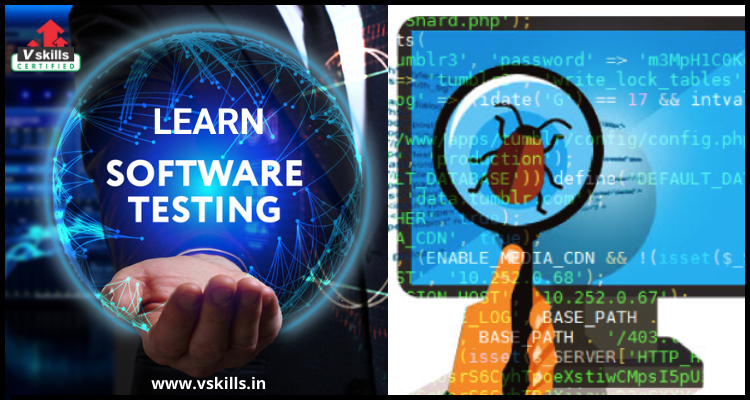The rapidly expanding software industry has resulted in an increase in demand for genuine, user-friendly, and dependable software. However, while there is a high demand for dependable software, its consistency cannot be compromised. As a result, it’s important to thoroughly test the product before putting it to professional use. Testing ensures that the software adheres to the established specifications and is capable of delivering the required results in a timely manner. So before we start let us learn more about the concept of software testing and sources to begin your learning.
What is Software Testing?
Software testing is a method of determining if the real software product meets the desired specifications and if it is defect-free. It entails the use of manual or automated methods to test one or more properties of interest by executing software/system components. In comparison to real specifications, software testing’s aim is to find bugs, holes, or missing requirements.
Some prefer saying Software testing as a White Box and Black Box Testing. In simple terms, Software Testing means the Verification of Application Under Test (AUT).
White Box and Black Box Testing
Software testing can be done in two ways: white box and black box. Consider them as two umbrellas in which various forms of research may be classified.
A white or glass box evaluation is one in which the tester is aware of the program’s internal workings. Based on experience of the application’s internal code, the tester creates a plan for testing the software. They know what the function does and which inputs will result in which outputs. This form of testing focuses on statement, line, and branch coverage, among other things.
Black box testing is a technique in which the tester is unaware of the program’s internal workings. The specifications and features are used to guide the testing process. One benefit of this method over white box testing is the ability to detect incomplete code statements. This method does not necessitate that the tester be fluent in the language in which the software was written. The unclear level of coverage that testing provides is a risk for this method of testing.
Significance of Software Testing
Software testing is important because it allows any defects or flaws in the software to be detected early and fixed before the software product is delivered. A well-tested software product ensures dependability, protection, and high efficiency, which saves time, money, and improves customer satisfaction. Mentioned below are the benefits that one can derive from the same:
Cost-Effective
It is one of the most significant benefits of software testing. Timely testing of any IT project allows you to save money in the long run. It is less expensive to patch bugs discovered earlier in the software testing phase.
Product Quality
Any software product must meet this requirement. Testing ensures that consumers receive a high-quality product.
Security
It is software testing’s most fragile and responsive benefit. People are searching for goods that they can trust. It aids in the early detection of threats and issues.
Customer Satisfaction
Any product’s primary goal is to provide consumer loyalty. The best user experience is ensured by UI/UX testing.
Software Life Cycle
Software testing, like software creation, entails a series of steps that must be completed in a strict order. The software testing life cycle, or STLC, is a term used to describe this process. It establishes the start, finish, and in-between points of the entire software testing process.
The Software Testing Life Cycle (STLC) is a term that refers to the process of testing software. STLC aids in the proper and rigorous execution of the research process. There are many stages to it, including specifications collection, review, and execution. There are specific deliverables, targets, and priorities for each step of the STLC. While different testers can approach phases differently, such as combining one or more into one, iterating, and so on, the basic concept remains the same. The stages of a software testing life cycle are as follows:
Requirements Gathering
The beginning of a software testing life cycle is marked by this process. The research team(s)/tester(s) participate in brainstorming sessions during this process to determine which features and sections of a software product should be tested.
The scope of the entire research effort is determined during the requirements gathering process. For functionality that cannot be checked, a mitigation technique must be devised.
Planning
This phase may be the first phase in some STLC methods, or it may be combined with the requirements gathering phase to form a single, coherent phase. The aim of the planning process is to determine all of the activities and resources required to meet the research goals and objectives.
During the planning process of the STLC, appropriate metrics, as well as methods for collecting and monitoring them, are also identified. The planning process is normally decided by three factors:
- Firstly, Prerequisites
- Secondly, Methodology for testing
- And then, Risk analysis, risk assessment, and risk reduction are all terms that are used interchangeably.
Analysis
In this STLC step, the “what” of the entire research methodology that the testing team(s)/tester(s) has developed so far is exploited. Analyzing the criteria is a simple way to generate testing conditions. All of this is accomplished by the use of leverage:
- Firstly, PRD (requirements document)
- Secondly, Risks associated with the product
- And then, Some testing grounds
It’s not easy to figure out what the test conditions are. You can figure out all the obvious ones, but the ones that aren’t so obvious, such as lurking variables, can prevent the team from learning exactly how aspects of the research method work.
Design
After determining what needs to be measured, the design phase of the software testing life cycle is where it is determined how to test. This process is divided into sub-tasks as follows:
- Firstly, to increase coverage, break down the testing conditions into many smaller, sub-conditions.
- Secondly, creating benchmarks for requirement traceability.
- Thirdly, creating benchmarks for test coverage.
- Fourthly, identifying the test data and obtaining it.
- Lastly, the test environment must be defined and set up.
Implementation
It’s time to put the right software testing methodology into action after the testing team(s) has figured out how and what to assess. During this process of the STLC, detailed test cases are developed. It’s important to understand the following:
- Firstly, the order in which the test cases should be run.
- Secondly, the test cases that will be used in the regression suite are identified.
- And, the adequacy of the test cases
When it comes to automation:
- Determine the test cases that should be considered.
- Then, continue scripting the test cases and go through them again.
Execution
The actual execution of test cases takes place here. Before approving execution, double-check that the entry condition has been met. Discrepancies arise as an unfavourable outcome of conducting the test cases. These can be logged as defects and reviewed later. Use traceability metrics to keep track of your success.
Conclusion
The conclusion is the next stage in the software testing life cycle. It concentrates on two topics: exit requirements and reporting.
The research team determines the frequency of test results with additional feedback from software project stakeholders, such as weekly (Weekly Status Reports a.k.a. WSR), twice a week, biweekly, 15-day, or even daily (Daily Status Report a.k.a. DSR).
The more familiar STLC project managers are with testing, the more technical details, such as defects raised, defect severity, and so on, would be useful to them. Details regarding defect mitigation are sufficient for non-technical stakeholders to be informed.
Closure
The final step of the software testing life cycle comprises the following:
- Checking and categorizing test cases according to their status, such as executed, mitigated, or other.
- Creating a text that details
- what went well and what didn’t
- Improvement potential (s),
- What can be done better, and how can the same be done better?
- Ascertaining that no high-severity defects are open.
The entire software testing life cycle can be summarised in this way. When testing a software application, many methods of testing are now used. The scale, scope, and mechanics of the software project under development are the basis for these assessments.
How can you learn Software Testing?
These e-learning courses will help everyone improve their skills, from beginners to expert software developers. Let’s take a look at some of the best software testing preparation resources:
Study Resources
Books are the best resources and always the first way that comes to our mind while preparing. You can choose the books as per your ease and level of understanding. There are many books that are available that can be used to clear your concepts and can provide you with insightful other topics too. This can be used to deal with the tricky part of the paper too. Some books that can be referred are –
- Firstly, Foundations of Software Testing Istqb Certification (English, Paperback, Black Rex)
- Secondly, Software Testing (English, Paperback, Desikan Srinivasan)
Online Training Courses
ISTQB Software Testing Foundation
Beginners interested in learning about software development and testing should enrol in this course. This course will give you a better understanding of the principles, from validating your technical skills to establishing a solid foundation in software testing. The syllabus of the course follows the International Software Testing Qualification Board requirements, which is a plus.
Best QA Manual Software Testing
This Udemy course is geared for beginners and provides students with a hands-on approach to a variety of software testing topics. You can gain practical experience working in a technical setting by working on real-time projects. In this course, all of the principles are well-explained.
VSkills Certification
Software Testing is the backbone of any IT product, Services Company. The industry size is about USD$13 billion globally and is one of the biggest recruiters and job creators around the world. Software testing can be manual and automated. Vskills certification will focus on the different concepts of testing, automated testing necessary documentation and project management needs; and metrics for testing, automated testing, and different tools for testing like load testing, cost-driven training, and GUI-based testing. Some different test automation tools will also be introduced.
Click here to check out the brochure.

Benefits of Certification
- Firstly, Government certification
- Secondly, Lifelong E-Learning access
- Thirdly, Free Practice Tests
- Fourthly, Certification valid for life
- Then, Get tagged as ‘Vskills Certified’ On Monsterindia.com
- Lastly, Get tagged as ‘Vskills Certified’ On
 Shine.com
Shine.com




